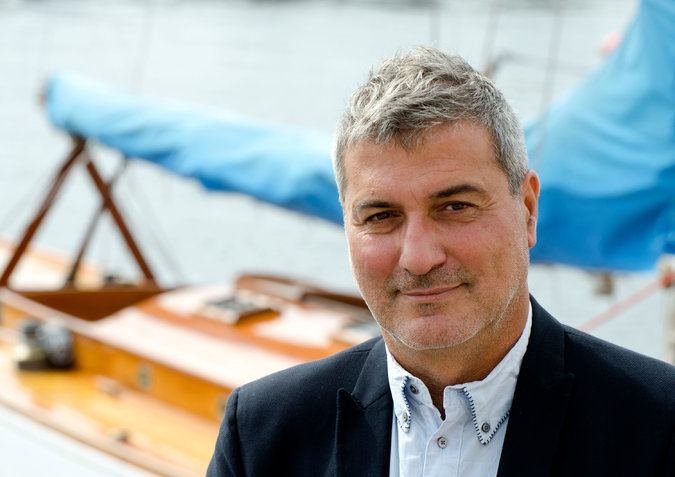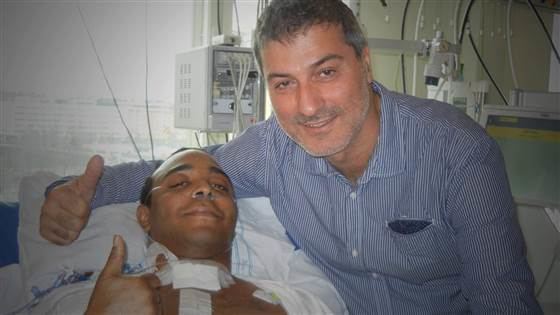Name Paolo Macchiarini | Role Professor | |
 Similar Thomas Starzl, Roy Yorke Calne, Roman Frederick Starzl | ||
Alcanzando el conocimiento entrevista al dr paolo macchiarini
Paolo Macchiarini (born August 22, 1958). M.D., Ph.D., is Professor of regenerative medicine at Karolinska Institutet in Stockholm (Sweden), and director of the Advanced Center for Regenerative Medicine (ACTREM) in the same Institute. He is also Honorary Professor at London University College. He is a pioneer in the field of regenerative medicine using both biological and synthetic scaffolds seeded with patients' own stem cells to regenerate trachea. He was previously the head and chairman of the Hospital Clinic (Barcelona Metro) in the University of Barcelona in Barcelona, Spain, and professor of surgery at the University of Barcelona, and at the Hannover Medical School in Hanover, Germany. Some of his academic credentials have been called into question by an article in Vanity Fair and he recently came into hot weather for alleged research misconduct.
Contents
- Alcanzando el conocimiento entrevista al dr paolo macchiarini
- Exclusive interview with scandal surgeon Paolo Macchiarini Nyheterna TV4
- Education
- Claudia Castillo First transplant using patients stem cells
- Ciaran Finn Lynch first child
- Andemariam Teklesenbet Beyene first synthetic trachea
- Christopher Lyles first US citizen to receive synthetic trachea
- Hannah Warren first baby to receive synthetic trachea
- Investigation
- References

Exclusive interview with scandal surgeon Paolo Macchiarini - Nyheterna (TV4)
Education

Macchiarini completed his residency in thoracic surgery at the University of Pisa in Pisa, Italy. He completed a fellowship in the department of thoracic and vascular surgery and heart-lung transplantation, Hopital Marie-Lannelongue, Paris-Sud University, Le Plessis Robinson, France.
Claudia Castillo: First transplant using patient's stem cells

In June 2008, Macchiarini conducted the world's first transplant of a donated trachea colonized with the stem cells of the patient, Claudia Castillo. "After a severe collapse of her left lung in March, Castillo needed regular hospital visits to clear her airways and was unable to take care of her children." The only treatment left to her following conventional medicine "was a major operation to remove her left lung which carries a risk of complications and a high mortality rate." Macchiarini proposed tissue engineering.
A team from Spain, the UK and Italy, collaborated on the surgery, which took place at Spain's Hospital Clinic of Barcelona. They stripped the donated organ of its cells and MHC antigens (involved in helping the body recognize foreign tissues). They used the remaining structure as a scaffold for the patient's own cells, which were cultured onto it.

The operation was an immediate success. "The graft immediately provided the recipient with a functional airway, improved her quality of life, and had a normal appearance and mechanical properties at 4 months. The patient had no anti-donor antibodies and was not on immunosuppressive drugs." The latter aspect was a significant advantage, as immunosuppressive drugs can "increase the risks of infection, malignancy, cardiovascular disease and bone marrow suppression." "The technique raises the prospect of transplants for patients whose organs are damaged by cancer, who then cannot take the drugs as they increase the risk of cancer returning."
Martin Birchall, then Professor of Surgery at the University of Bristol, commented on the importance of the operation's success: “Surgeons can now start to see and understand the very real potential for adult stem cells and tissue engineering to radically improve their ability to treat patients with serious diseases. We believe this success has proved that we are on the verge of a new age in surgical care”.
Castillo was reported to be in good health six years after the surgery.
Ciaran Finn-Lynch: first child
March 2010: Ciaran Finn-Lynch is the first child to receive stem cell organ treatment, and also had the "longest airway that has ever been replaced." He was 10 years old when an earlier transplanted trachea (with metal stents) started to cut into his aorta, the main blood vessel coming out of his heart. After several operations, there was still bleeding from the stents. With no other options in sight, the team leader thought of Macchiarini's earlier success with Castillo.
Macchiarini joined colleagues at London's Great Ormond Street Hospital during the operation, which was led by Martin Elliott (surgeon), and included Martin Birchall of University College London. Macchiarini seeded the child's stem cells to the donated trachea and applied growth factor chemicals. He explained, "We told the cells to differentiate and transform naturally into the layers that make up the airway."
Due to the urgency of the child's condition, surgeons weren't able to wait for the patient's stem cells to develop into trachea cells in the lab. Martin Birchall said: "To minimise delays, we bypassed the usual process of growing cells in the laboratory over a period of weeks, and instead opted to grow the cells inside the body, in a similar manner to treatments currently being trialed with patients who have had heart attacks." Using this technique, "the boy's trachea was ready to be implanted in just four hours." The entire operation lasted nearly nine hours.
The operation was successful. On March 20, 2010, team leader Martin Elliott said, "The child is extremely well. He's breathing completely for himself and speaking, and he says it's easier for him to breathe than it has been for many years." After six months, his trachea looked almost normal, and his progress continued.
In April 2013, then 14-year-old Finn-Lynch was honoured with a Pontifical Hero Award for his courage, during the Second International Adult Stem Cell conference at the Vatican. He was the second person to receive the award.
Macchiarini believed that the implications for future treatments went beyond organ replacement, to the healing of damaged organs with stem cell therapy. "We need to change our philosophy…. The question is do we really need to transplant the entire organ and put the patient on immunosuppression, or can we stimulate stem cells to make it function again?" Martin Birchall said that more clinical trials were needed, but was hopeful that the technique could "allow not just highly specialized hospitals to carry out stem cell organ transplants."
Andemariam Teklesenbet Beyene: first synthetic trachea
On June 9, 2011 at Karolinska University Hospital in Stockholm, Sweden, doctors including Macchiarini implanted a synthetic windpipe built up with the patient's own stem cells, into a 36-year-old man with late-stage tracheal cancer. The synthetic windpipe was made at University College London, by Professor Alexander Seifalian.
A video of Andemariam 1 year after the transplantation is available here.
According to information uncovered by the Swedish documentary "Dokument Inifran: Experimenten" (Swedish: "Documents from the Inside: The Experiments") Andemariam went from suffering an increasingly terrible and eventually bloody cough to dying, incubated, in the hospital. At that point, determined by autopsy, 90% of the synthetic windpipe had come loose. He allegedly made several trips to see Macchiarini for his complications, and at one point had surgery again to have his synthetic windpipe replaced, but Macchiarini was notoriously difficult to get an appointment with. According to the autopsy, the old synthetic windpipe did not appear to have been replaced.
Christopher Lyles: first U.S. citizen to receive synthetic trachea
The second person in the world, and the first in the U.S., to receive a synthetic trachea engineered with the patient's own stem cells, was Christopher Lyles of Abingdon, Maryland. He had "exhausted the limited treatment options available in the U.S. for his tracheal cancer." Mr. Lyles was operated on in Stockholm, Sweden, in November 2011, and returned home to Baltimore in January 2012. "'I’m feeling good,' Mr. Lyles said in a telephone interview from his home, where he was playing with his 4-year-old daughter. 'I’m just thankful for a second chance at life.'" Sadly, Mr. Lyles died in March 2012, nearly four months after the surgery. Mr. Lyles' family continue to be supportive of the therapy, stating "Christopher was a recipient and strong advocate of stem cell therapy.… We hope his bravery will pave the way for further research and development and acceptance of stem-cell-based therapies in the United States."
Hannah Warren: first baby to receive synthetic trachea
Hannah Warren of Korea was born in August 2010 with an underdeveloped trachea. She survived for 2 months thanks to a tube inserted in a bronchus through the oesophagus and an aesophagus-broncus fistula. In April 2013, at the Children's Hospital of Illinois at OSF Saint Francis Medical Center (in a 9-hour procedure working with local pediatric surgeon Mark Holterman- the parents, a Newfoundland, Canada man and a South Korean woman living in her country), he gave a 3-inch long, bone marrow stem cell-cultured artificial trachea, or windpipe, to 2-year-old Hannah Warren, who had until then spent all her life in the Seoul National University Hospital in Seoul, South Korea, and was initially not expected to survive. She was the youngest patient yet to undergo that procedure, and only about 50,000 people in the world have her condition. Sadly, Hannah died a few months later on July 6, 2013. Her family stated: "She is a pioneer in stem-cell technology and her impact will reach all corners of our beautiful Earth. Her new trachea was performing well, but her lungs went from fairly good, to weak, to poor."
Investigation
Macchiarini was accused of having performed operations without informed consent, required by the declaration of Helsinki, as well as research misconduct. The Karolinska Institute launched an internal investigation, and after considering the 1000 pages rebuttal of Macchiarini and other co-authors of the articles, the Karolinska Insitute dismissed the allegations.
Macchiarini commented on the dismissal of the accusations, saying that the accusations had been "extremely damaging: to me, to my team and to the whole field of regenerative medicine. To have been falsely accused of such serious misconduct is every researcher’s nightmare."
Swedish authorities were not of the same mind as Macchiarini's employers at the Karolinska Institute and both the MPA (Medical Products Agency) and the Health and Social Care Inspectorate have pressed formal charges. The charges against him, for which he is still under investigation, are manslaughter and bodily harm.
Unimpressed was also the independent investigator Bengt Gerdin who the Karolinska Insitute originally brought in to review the case. Having read the rebuttal from Macchiarini and co-authors he says he has found nothing which would disprove the scientific misconduct his original investigation uncovered. Also, in a letter to the Karolinska Institute he strongly criticises how the matter has been handled, and in an interview with Swedish SVT has said that by ultimately handling the matter internally the Karolinska Institute has effectually made bringing him in as an unbiased party pointless. So far the Karolinska Institute has not budged on their earlier dismissal.
A story published by Vanity Fair has strongly suggested that Macchiarini has fabricated large parts of his academic resume. The article paints him as a serial fabulist, detailing an alleged courtship and marriage arrangements with a NBC News producer despite Macchiarini being married at the time. The Karolinska Institute is currently looking into the allegations in regards to Macchiarini's resume.
